One of the many areas of modern dentistry - orthodontist. Many people do not fully understand or are not familiar with what he does and how he can help a person. However, most of them could go to a specialist to correct even minor defects in the oral cavity.
Record content:
- 1 Orthodontics in dentistry
- 2 What does an orthodontist treat?
-
3 Functions of the orthodontist and treatment features, differences between children and adults
- 3.1 Child
- 3.2 Adult
- 4 Directions of orthodontic treatment
- 5 Dental technician's area of work
- 6 Classification of methods of orthodontic treatment
-
7 Types of orthodontic appliances
- 7.1 Characteristics of ligature braces
- 7.2 Ligature-free braces
- 7.3 Katz Bite Crown
- 8 Installation of braces
- 9 Removing the bracket system
- 10 Taking proper care of your teeth while wearing braces
- 11 Videos about orthodontists
Orthodontics in dentistry
Orthodontics is translated from Greek as “straight, correct tooth”. The specificity of the profession is to correct the pathological structure of the jaw and the shape of the tooth. The majority of clients are children and adolescents, since at the stage of active growth, it remains possible to quickly correct disorders in the oral cavity. At the same time, it takes much less time than in an older person.
Also, in children, the area of influence extends beyond the chewing-speech apparatus. Additionally, some violations that were formed in the process of growth can be corrected. But orthodontics does not deal with defects resulting from injury or illness. This area belongs to orthopedic dentistry.
What does an orthodontist treat?
One of the founders of the direction was Norman Kingsley, a scientist whose activities led to the separation of orthodontics into a separate medical science. He found that the extra traction that can be created with special designs gradually leads to changes in the shape of the teeth.
Previously, these devices were of considerable size. Fastening was carried out on the neck and shoulders.
The sequence of basic manipulations:
- a specialist forms braces according to the individual structure of the client's jaw;
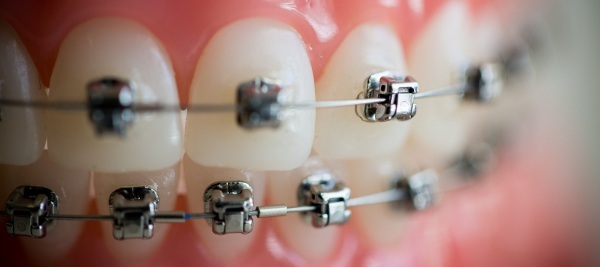
- braces consist of separate locks that are fixed to each other;
- for this, small elastic bands made of safe materials are used;
- after the assembly of the structure, the period of correcting the shape of the teeth begins;
- its duration depends on the degree of pressure of the braces and violations.
As the defects are corrected, the pressure decreases, so the client must visit the orthodontist regularly to adjust the strength of the impact. In this case, it is forbidden to independently remove parts of the structure, since this will most likely lead to the loss of the achieved result.
Functions of the orthodontist and treatment features, differences between children and adults
An orthodontist (which the doctor does is discussed below) performs procedures in adults and children, which practically do not have any special differences. The only difference lies in the plasticity of children's jaws. But adults also have every chance to correct existing defects in the structure and shape of the dentition.
Criteria for choosing a professional specialist | |
| Recommendations of friends | Many people seek this kind of help. Therefore, before starting your search, you should ask people you know about the availability of a permanent orthodontist or dentist. |
| Study visit | Most companies organize some kind of open house days. At such events, you can get acquainted with the practice of the doctor and learn about his personal achievements. |
| Certificates | Usually papers confirming the degree of qualification are located on the wall in the office. There is nothing wrong with going up and familiarizing yourself with them. |
| Portfolio | Many doctors who deal with human appearance have before and after photographs. They allow you to visually verify the level of professionalism. |
Also, one should not strive for excessive savings. Dentistry and orthodontics are expensive medical services.
Child
Deviations in the development of the jaws are found in 80% of children. At this age, the main criterion for assessing the structure is the correct bite, in which the teeth should be evenly closed. 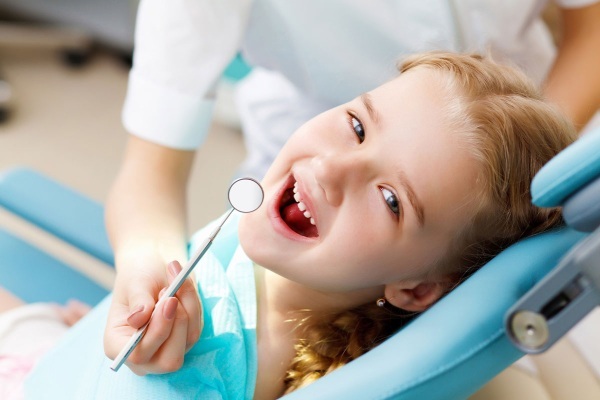 In some cases, the teeth protrude significantly forward both in the lower jaw and in the upper one. Therefore, it is advisable to correct the wrong position as early as possible.
In some cases, the teeth protrude significantly forward both in the lower jaw and in the upper one. Therefore, it is advisable to correct the wrong position as early as possible.
Adult
Turning to the clinic to a specific specialist, you can be sure that his work experience is based on the characteristics associated with age. Therefore, the doctor will offer exactly those options for bracket systems that, without much discomfort and in a short time, will improve the appearance of the oral cavity.
Directions of orthodontic treatment
When choosing a method of treatment, an orthodontist is guided by the presence of the following defects:
- large distances between individual teeth;
- problems with the pronunciation of some sounds;
- crowding of teeth and deformation of the jaw;
- type and severity of malocclusion;
- wrong direction of tooth growth;
- asymmetrical features.
The area of influence and the degree of intervention here is significantly less than that of therapeutic dentists. The main goal of their activity is not a healthy state of the teeth, but an even and beautiful smile.
Dental technician's area of work
A dental technician is a specialist who, in cooperation with an orthodontist, takes impressions from the patient's teeth for further manufacturing of the prosthesis and its installation.
During the procedure, several parameters are determined:
- optimal type of material;
- choice of shape and shade.
The development of prosthetics methods, the expansion of the choice of materials is happening quite quickly. Therefore, high-level specialists are becoming more and more in demand in dentistry. The wages are also high.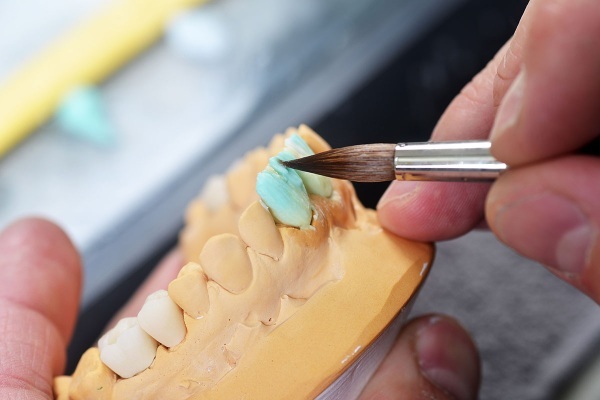
Requirements for dental technicians:
- spatial-figurative thinking;
- high sensitivity of the fingers;
- ability to concentrate;
- psychological stability;
- developed coordination;
- accurate eye;
- good vision;
- accuracy.
The specialist performs all the work in the dental laboratory. Quite often, dental technicians delve into the manufacture of certain types of prostheses, which, with a detailed approach, fit perfectly into the patient's jaw.
Classification of methods of orthodontic treatment
Orthodontic treatment methods are ways to correct defects in the development of the jaw and the growth of teeth using special equipment and therapeutic exercises. In some cases, they are allowed and recommended to be combined with surgical interventions.
Abnormal changes in the oral cavity are divided into 2 types:
- malformations of the jaws;
- defects in the growth of teeth.
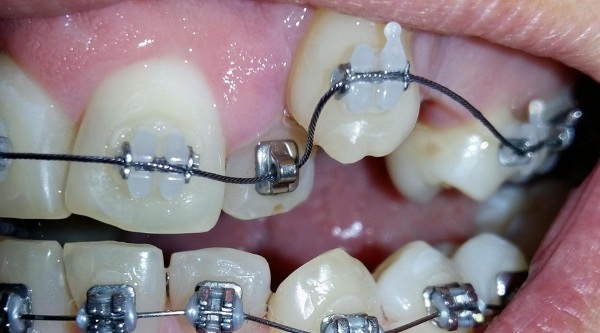
Orthodontist treats tooth growth abnormalities
The most common problem among patients is malocclusion. In this case, the lower teeth can be put forward, have a non-standard direction or intersect.
Possible complications of malocclusion:
- insufficient quality chewing of food;
- as a result, the appearance of gastritis or stomach ulcers;
- the risk of developing periodontitis and diseases of the organs of the body;
- persistent, bad breath;
- load on the temporomandibular joints.
It is for these reasons that orthodontists strongly recommend that all people practice their teeth in order to avoid unpleasant consequences.
Types of orthodontic appliances
Bracket systems occupy a special position among the methods of treatment. Previously, these were massive metal structures. Ceramic braces are now popular.
They are of 2 types:
- ligature;
- ligature-free.
The choice should be made on the basis of the testimony and the client's willingness to endure certain inconveniences for a sufficiently long period of time.
Characteristics of ligature braces
Constructions are divided into removable and permanent. Ligature braces consist only of an arch, in separate locks of which there are small cavities for its attachment. The durable ring gently but securely holds the arc in place. This is what is called a ligature.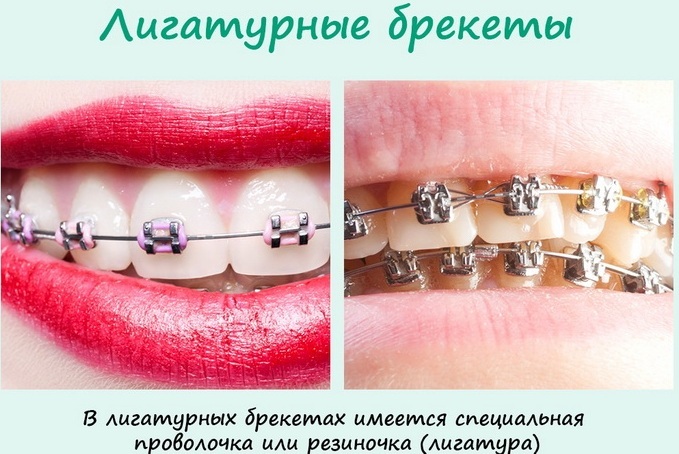
Some features of ceramic ligature braces:
- the ability to choose a color, which in the case of children or adolescents becomes a significant plus;
- elastic ligature compensates for excessive pressure on the surface of the teeth;
- due to elasticity, it takes more time to align the dentition;
- fastening is carried out in a stationary form, which in the future can lead to discomfort during wearing;
- dyes, tea and coffee give a specific shade after contact with them;
- maintenance is usually difficult and requires the use of special devices to completely remove plaque and food debris.
But all these drawbacks are relatively easy to eliminate by regular brushing using toothbrushes and small brushes.
Ligature-free braces
Constructions without ligatures are manually adjustable, their other name is self-ligating. Thanks to the use of systems of this type, it is possible to correct the bite in the shortest possible time. At the same time, the pressure elements can be easily changed to increase efficiency when the alignment has begun and the pressure can be repeatedly adjusted throughout the entire stage of wearing the bracket system. The arc is not fixed too rigidly, which removes possible discomfort.
The main disadvantage of both types is the rather high cost of both the system itself and the procedures for further maintenance.
Katz Bite Crown
This is the name of the plastic structure, which, after installation, will contact the necks of the posterior teeth, and there will be no contact in the front part. Fastening in the last zone is done with 4 metal hooks by throwing over the edges of the 4 upper central incisors.
The principle of effectiveness is based on the use of pressure on the teeth, which is created during the process of chewing food. At the same time, the line gradually shifts forward, and the dentition becomes more and more even.
In addition to those listed, many other devices are used. But the most popular are still braces.
Installation of braces
Before choosing their type and then establishing, the doctor will assess in detail the condition of the oral cavity. In the presence of carious lesions of varying degrees of severity, it is imperative to bring the condition of the teeth back to normal.
The procedure for installing braces consists of several stages:
- during the preparation process, the doctor will insert a special expander, thanks to which the specialist will simultaneously see all the teeth at once;
- then you will need to polish the enamel surface and apply a restoring mixture for 30 s;
- fixation of individual links and locks is carried out using special dental glue;
- further, under the influence of ultraviolet radiation, the orthodontic cement will harden and will reliably hold the structure;
- at the end of the procedure, you will need to insert the bracket into the locks and fix it with ligatures.
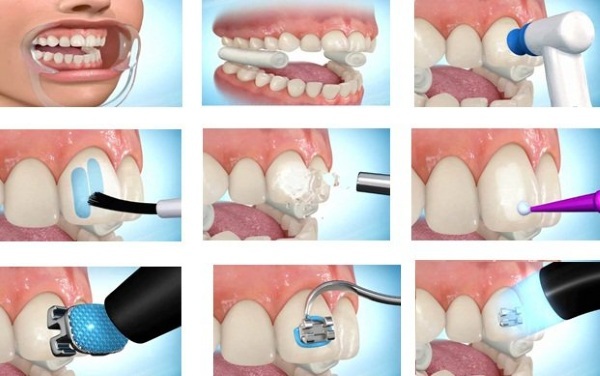
At the very beginning of wearing braces, almost all patients experience discomfort associated with high blood pressure. But in the subsequent period, when the line of the dentition begins to align, they will gradually decrease.
Removing the bracket system
Even a specialist in this field cannot determine the approximate wearing period. The duration of the alignment will depend on the individual tooth resistance to external pressure. When the orthodontist and the client achieve a positive result, the braces will need to be removed. The procedure is simple and takes no more than 10 minutes in time.
The orthodontist usually acts from his own experience, which he can do for this:
- some specialists first remove the arc, and then remove the locks;
- other orthodontists alternately remove parts of the bracket along with the arch and ligature;
- for this, special dental forceps of a special shape are used;
- they squeeze the lock, as a result of which it easily bounces off the surface of the tooth;
- after the bracket has been completely removed, the teeth are carefully ground to remove any adhesive residues.
For this, experts use a fine notch such as sandpaper and act with extreme caution. After completing the procedure, no special care measures are required, except for routine cleaning and other daily manipulations.
Taking proper care of your teeth while wearing braces
The orthodontist (which the professional does as discussed above) recommends to clients:
- high-quality cleansing from any contamination;
- rinsing the mouth with special concentrates;
- using small brushes;
- irrigators and professional care.
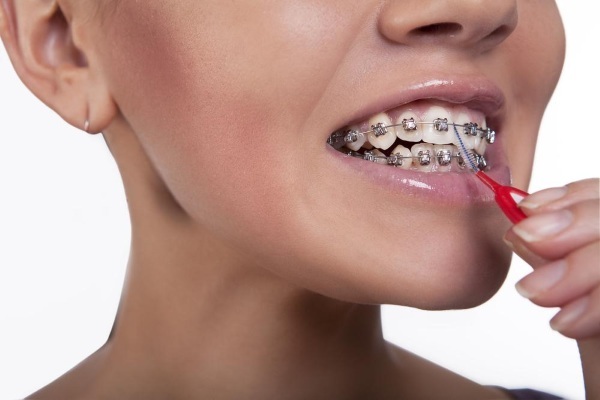
All individual elements of braces are foci for the development of pathogens. They can lead to tooth decay and other pathologies of the teeth and gums. Therefore, during the entire period of wearing the bracket system, special attention should be paid to the procedure for cleansing plaque and small food debris.
The direction of the brush should always be from the roots of the teeth to the incisal edge. Movement along the dentition will not only not clean them, but will also contribute to the deepening of plaque between the teeth and accumulation in the gum pockets. The brush should be taken of medium hardness, the paste should be of high quality.
Another important principle of proper care is the use of rinses with herbal extracts, minerals and antiseptic additives. Some of the products presented in stores also contain fluorides, which effectively help to suppress the development of carious lesions.
In addition to the usual brush, it is recommended to use special brushes for braces. They are characterized by a small diameter and easily penetrate between structural elements and the tooth surface. Brushes allow you to completely remove all dirt. Due to their compactness, they are easy to carry with you at all times.
Superfloss can be used instead of regular dental floss. It differs in that its tip is quite hard. Therefore, superfloss easily removes food debris.
An orthodontist (what he does and what he uses at a professional level) uses in his work:
- irrigators - these are special devices that help remove all food debris with a thin stream of water and can be used for home care;
- orthodontic wax treatment protects the cheeks from hard parts due to a significant increase in the smoothness of all parts of the braces.
Any orthodontist with sufficient experience is able to perform the ideal installation of any system. But at the same time, one should not forget about one's own responsibility.
What needs to be done for this, the specialist will explain, if necessary. In the future, you will only need to adhere to the recommendations, use high-quality care compositions and other convenient devices.
Article design: Vladimir the Great
Videos about orthodontists
10 stupid questions to the orthodontist:
